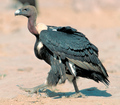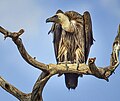Aegypiinae
This article includes a list of general references, but it lacks sufficient corresponding inline citations. (October 2018) |
| Aegypiinae | |
|---|---|

| |
| Lappet-faced vultures (left) and a white-backed vulture | |
| Scientific classification | |
| Domain: | Eukaryota |
| Kingdom: | Animalia |
| Phylum: | Chordata |
| Class: | Aves |
| Order: | Accipitriformes |
| Family: | Accipitridae |
| Subfamily: | Aegypiinae |
| Genera | |
|
See text. | |
The Aegypiinae is one of two subfamilies of Old World vultures, the other being the Gypaetinae.
Species
| Subfamily | Genus | Common and binomial names | Image | Range |
|---|---|---|---|---|
| Aegypiinae | Aegypius | Cinereous vulture Aegypius monachus |

|
Southwestern and central Europe, Turkey, the central Middle East, northern India, central and east Asia |
| †Aegypius jinniushanensis | Formerly China | |||
| †Aegypius prepyrenaicus | Formerly Spain | |||
| Gyps | Griffon vulture Gyps fulvus |

|
Mountains in southern Europe, north Africa and Asia | |
| White-rumped vulture Gyps bengalensis |

|
Northern and central India, Pakistan, Nepal, Bangladesh and southeast Asia | ||
| Rüppell's vulture Gyps rueppelli |

|
The Sahel region of central Africa | ||
| Indian vulture Gyps indicus |

|
Central and peninsular India | ||
| Slender-billed vulture Gyps tenuirostris |

|
The Sub-Himalayan regions of India and into Southeast Asia | ||
| Himalayan vulture Gyps himalayensis |

|
The Himalayas and Tibetan Plateau | ||
| White-backed vulture Gyps africanus |

|
Savannahs of west and east Africa | ||
| Cape vulture Gyps coprotheres |

|
Southern Africa | ||
| Necrosyrtes | Hooded vulture Necrosyrtes monachus |

|
Sub-Saharan Africa | |
| Sarcogyps | Red-headed vulture Sarcogyps calvus |

|
The Indian Subcontinent, with small disjunct populations in Southeast Asia | |
| Torgos | Lappet-faced vulture Torgos tracheliotos |

|
Sub-Saharan Africa, the Sinai and Negev deserts and north-west Saudi Arabia | |
| Trigonoceps | White-headed vulture Trigonoceps occipitalis |

|
Sub-Saharan Africa. Extinct populations occur in Indonesia.[1] | |
| †Neogyps |
† = extinct
References
- Ferguson-Lees, James; Christie, David A. (2001). Raptors of the World. Illustrated by Kim Franklin, David Mead, and Philip Burton. Houghton Mifflin. ISBN 978-0-618-12762-7. Retrieved 2011-05-26.
{{cite book}}: Invalid|ref=harv(help) - Grimmett, Richard; Inskipp, Carol; Inskipp, Tim (1999). Birds of India, Pakistan, Nepal, Bangladesh, Bhutan, Sri Lanka, and the Maldives. Illustrated by Clive Byers et al. Princeton University Press. ISBN 978-0-691-04910-6. OCLC 43578307.
{{cite book}}: Invalid|ref=harv(help) - Lerner, Heather R. L.; Mindell, David P. (November 2005). "Phylogeny of eagles, Old World vultures, and other Accipitridae based on nuclear and mitochondrial DNA" (PDF). Molecular Phylogenetics and Evolution. 37 (2): 327–346. doi:10.1016/j.ympev.2005.04.010. ISSN 1055-7903. PMID 15925523. Retrieved 31 May 2011.
{{cite journal}}: Invalid|ref=harv(help)
- ^ Hanneke J.M.; et al. "Continental-style avian extinctions on an oceanic island" (PDF). Repository.si.edu. Retrieved 17 October 2018.
